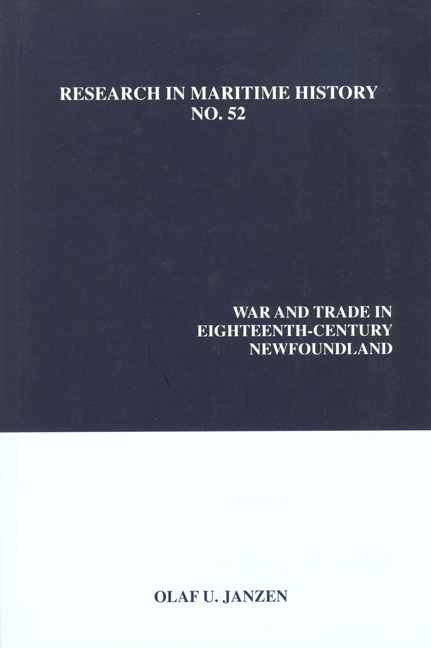Book contents
- Frontmatter
- Table of Contents
- About the Author
- Introduction
- “‘A World Embracing Sea:’ The Oceans as Highway, 1604-1815”
- “Of Consequence to the Service:' The Rationale behind Cartographic Surveys in Early Eighteenth-Century Newfoundland”
- “The Problem of Piracy in the Newfoundland Fishery in the Aftermath of the War of the Spanish Succession”
- “A Scottish Sack Ship in the Newfoundland Trade, 1726-1727”
- “'Une petite Republique' in Southwestern Newfoundland: The Limits of Imperial Authority in a Remote Maritime Environment”
- “The Illicit Trade in English Cod into Spain, 1739-1748”
- “Un Petit Dérangement: The Eviction of French Fishermen from Newfoundland in 1755”
- “The French Raid upon the Newfoundland Fishery in 1762: A Study in the Nature and Limits of Eighteenth-Century Sea Power”
- “Showing the Flag: Hugh Palliser in Western Newfoundland, 1763-1766”
- “The Royal Navy and the Interdiction of Aboriginal Migration to Newfoundland, 1763-1766”
- “The Royal Navy and the Defence of Newfoundland during the American Revolution”
- “The American Threat to the Newfoundland Fisheries, 1776-1777”
- Appendix
“The American Threat to the Newfoundland Fisheries, 1776-1777”
- Frontmatter
- Table of Contents
- About the Author
- Introduction
- “‘A World Embracing Sea:’ The Oceans as Highway, 1604-1815”
- “Of Consequence to the Service:' The Rationale behind Cartographic Surveys in Early Eighteenth-Century Newfoundland”
- “The Problem of Piracy in the Newfoundland Fishery in the Aftermath of the War of the Spanish Succession”
- “A Scottish Sack Ship in the Newfoundland Trade, 1726-1727”
- “'Une petite Republique' in Southwestern Newfoundland: The Limits of Imperial Authority in a Remote Maritime Environment”
- “The Illicit Trade in English Cod into Spain, 1739-1748”
- “Un Petit Dérangement: The Eviction of French Fishermen from Newfoundland in 1755”
- “The French Raid upon the Newfoundland Fishery in 1762: A Study in the Nature and Limits of Eighteenth-Century Sea Power”
- “Showing the Flag: Hugh Palliser in Western Newfoundland, 1763-1766”
- “The Royal Navy and the Interdiction of Aboriginal Migration to Newfoundland, 1763-1766”
- “The Royal Navy and the Defence of Newfoundland during the American Revolution”
- “The American Threat to the Newfoundland Fisheries, 1776-1777”
- Appendix
Summary
During the War of American Independence, American privateers and warships caused grave concern among the fishermen, merchants and naval and military authorities at Newfoundland. Strenuous steps were taken to defend the fishery against their activities. The larger outports were provided with gun batteries, while British warships patrolled the fishery, capturing a few dozen American vessels, although not without suffering some losses of their own. Despite these efforts, many fishing vessels suffered at the hands of the privateers, especially in the opening years of the war. Sails were plundered; rigging, supplies and even men were taken; and the fishing vessels themselves were often destroyed. By 1778, the bank fishery virtually ceased to exist. It has therefore been reasonable for most historians to assume that Newfoundland and its fishery were favourite targets of the Americans, and that only through the determined efforts of British military and naval authorities, and with the cooperation of the people of Newfoundland, were they beaten back.
This interpretation is now coming under scrutiny and revision. Instead of being the principal objects of privateer attention, it appears that fishing vessels and settlements were “targets of opportunity” as the Americans cruised the busy trade lanes linking the West Indies and North America with Europe. Supporting this contention is the fact that most American activity was reported to the south of St. John's, in those Newfoundland waters which lay adjacent to the transatlantic trade lanes. Hardly any privateers were reported to the north. Fishing vessels were meagre targets for privateers, who were intent on only one thing – capturing merchantmen with rich cargoes which would bring a profit to their crew and their owners. Plundering a fishing vessel rewarded the privateer with only one precious thing – time. The stores, gear and men taken from the victim would permit the privateer to extend its cruise and improve its chances of capturing a truly worthwhile prize. The American threat to Newfoundland was therefore almost an incidental one.
Nevertheless, it is also true that on at least one occasion Patriot leaders planned the destruction of the British fishery at Newfoundland, while less than a year later two Continental frigates actually did attack the fishery. The value of the Newfoundland fishery to England as a source of wealth and as a “nursery for seamen” was a truism of the eighteenth century.
- Type
- Chapter
- Information
- War and Trade in Eighteenth-Century Newfoundland , pp. 215 - 233Publisher: Liverpool University PressPrint publication year: 2013



